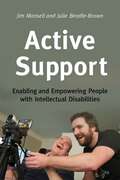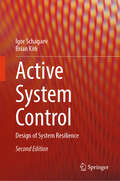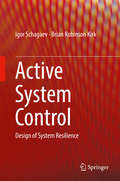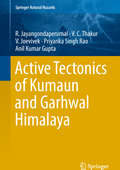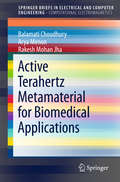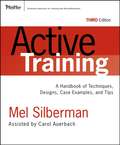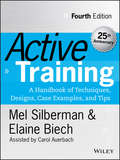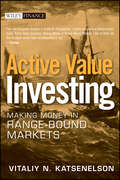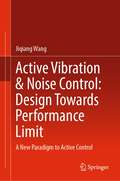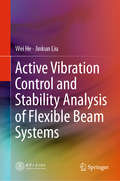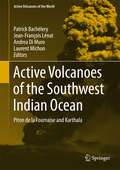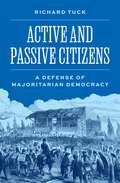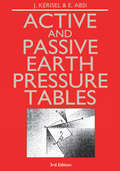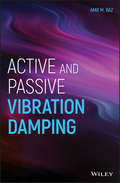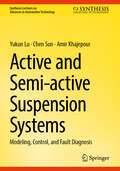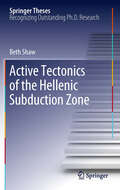- Table View
- List View
Active Support
by Jim Mansell Julie Beadle-BrownActive Support is a proven model of care that enables and empowers people with intellectual disabilities to participate fully in all aspects of their lives. This evidence-based approach is particularly effective for working with people with more severe disabilities, and is of growing interest to those responsible for providing support and services. The authors provide a comprehensive overview of Active Support and how it can be used in practice, based on the theory and research underpinning the methods involved. They describe how to engage people with intellectual disabilities in meaningful activity as active participants, and look at the communication style needed to foster positive relationships between carers and the people they are supporting. Highlighting the main issues for those trying to put Active Support into practice, they explain what is needed on a day-to-day basis to support the implementation, improvement and maintenance of the approach, along with possible solutions for the difficulties they may encounter. Finally, they look at how to integrate Active Support with other person-centred approaches, drawing on examples from various organisations and individual case studies. The definitive text on Active Support, this book will be essential reading for anyone professionally concerned with the quality of life of people with intellectual disabilities, including psychologists, behaviour specialists, social workers, care managers, occupational therapists and inspectors and regulators of services, as well as families.
Active Surveillance for Localized Prostate Cancer: A New Paradigm for Clinical Management (Current Clinical Urology)
by Laurence KlotzActive Surveillance for Localized Prostate Cancer: A New Paradigm for Clinical Management will serve as a useful resource for physicians dealing with, and interested in, this complex and evolving branch of prostate cancer management. The book will also be of interest to scientifically literate patients and their families. The volume provides an introduction to the concept of active surveillance in oncology in general and prostate cancer specifically. The primary focus is to provide a comprehensive guide to the management of patients on surveillance. The volume covers the many complexities and nuances to this approach including, patient selection, risk assessment, how to overcome 'cancer hysteria' when counseling patients, identifying appropriate triggers for intervention, use of PSA kinetics and MR imaging information, technique and frequency of biopsies, secondary prevention interventions, and the relative roles of surveillance and focal therapy.
Active Surveillance for Localized Prostate Cancer: A New Paradigm for Clinical Management (Current Clinical Urology)
by Laurence KlotzActive Surveillance for Localized Prostate Cancer: A New Paradigm for Clinical Management will serve as a useful resource for physicians dealing with, and interested in, this complex and evolving branch of prostate cancer management. The book will also be of interest to scientifically literate patients and their families. The volume provides an introduction to the concept of active surveillance in oncology in general and prostate cancer specifically. The primary focus is to provide a comprehensive guide to the management of patients on surveillance. The volume covers the many complexities and nuances to this approach including, patient selection, risk assessment, how to overcome 'cancer hysteria' when counseling patients, identifying appropriate triggers for intervention, use of PSA kinetics and MR imaging information, technique and frequency of biopsies, secondary prevention interventions, and the relative roles of surveillance and focal therapy.
Active System Control: Design of System Resilience
by Brian Kirk Igor SchagaevNow in its second edition, this book introduces an approach to active system control. This approach, when applied through design and development improves our technological systems. It extends concepts of system control using data accumulation, state and structural dependencies. The authors define these properties in terms of reliability, performance and energy-efficiency, and self-adaption. They describe how they bridge the gap between data accumulation and analysis in terms of interpolation with the real physical models when data used for interpretation of the system conditions. The authors introduce a principle of active system control and safety - an approach that explains what a model of a system should have, making computer systems more efficient, a crucial new concern in application domains such as safety critical, embedded and low-power autonomous systems like transport, healthcare, and other dynamic systems with moving substances and elements. On a theoretical level, this book further extends the concept of fault tolerance, introducing a system level of design for improving overall efficiency. On a practical level it illustrates how active system approach might help our systems become self-evolving. This updated new edition of Active System Control contains new chapters on the system software concept and the future of active systems control and a chapter containing case studies of unsolved aviation safety incidents.
Active System Control: Design of System Resilience
by Igor Schagaev Brian Robinson KirkThis book introduces an approach to active system control design and development to improve the properties of our technological systems. It extends concepts of control and data accumulation by explaining how the system model should be organized to improve the properties of the system under consideration. The authors define these properties as reliability, performance and energy-efficiency, and self-adaption. They describe how they bridge the gap between data accumulation and analysis in terms of interpolation with the real physical models when data used for interpretation of the system conditions. The authors introduce a principle of active system control and safety - an approach that explains what a model of a system should have, making computer systems more efficient, a crucial new concern in application domains such as safety critical, embedded and low-power autonomous systems like transport, healthcare, and other dynamic systems with moving substances and elements. On a theoretical level, this book further extends the concept of fault tolerance, introducing a system level of design for improving overall efficiency. On a practical level it illustrates how active system approach might help our systems be self-evolving.
Active Tectonics and Seismic Potential of Alaska
by Jeffrey T. Freymueller Peter J. Haeussler Robert L. Wesson Göran EkströmPublished by the American Geophysical Union as part of the Geophysical Monograph Series, Volume 179. This multidisciplinary monograph provides the first modern integrative summary focused on the most spectacular active tectonic systems in North America. Encompassing seismology, tectonics, geology, and geodesy, it includes papers that summarize the state of knowledge, including background material for those unfamiliar with the region; address global hypotheses using data from Alaska; and test important global hypotheses using data from this region. It is organized around four major themes: subduction and great earthquakes at the Aleutian Arc, the transition from strike slip to accretion and subduction of the Yakutat microplate, the Denali fault and related structures and their role in accommodating permanent deformation of the overriding plate, and regional integration and large-scale models and the use of data from Alaska to address important global questions and hypotheses. The book's publication near the beginning of the National Science Foundation's EarthScope project makes it especially timely because Alaska is perhaps the least understood area within the EarthScope footprint, and interest in the region can be expected to rise with time as more EarthScope data become available.
Active Tectonics of Kumaun and Garhwal Himalaya (Springer Natural Hazards Ser.)
by Anil Kumar Gupta R. Jayangondaperumal V. C. Thakur V. Joevivek Priyanka Singh Rao<P>The book contributes to understanding the pattern of strain release and the level of seismic hazard imposed by large-great earthquakes in the frontal fold-thrust belts of Kumaun and Garhwal regions of Uttarakhand. <P>The motivation for active fault studies and their characterization have been emphasized. The book presents the compilation of knowledge garnered in multidisciplinary or proxy studies involved in the understanding of seismic hazard in general and Kumaun–Garhwal Himalaya regions in particular with lucid new maps draped on modern Cartosat or SRTM DEM data. <P>It also discusses satellite image calibration, active faults identifications, and map productions with flowchart. The book discusses window-wise active fault elements with attributes together with the tectonic geomorphic map. It also includes active fault scarp with topographic profile along with field photographs. Finally, it reviews all existing seismotectonic models of the Himalaya, its earthquake hazard, and its vulnerability, specifically for Kumaun and Garhwal regions.
Active Terahertz Metamaterial for Biomedical Applications (SpringerBriefs in Electrical and Computer Engineering)
by Rakesh Mohan Jha Balamati Choudhury Arya MenonThis book describes a metamaterial-based active absorber for potential biomedical engineering applications. Terahertz (THz) spectroscopy is an important tool for imaging in the field of biomedical engineering, due to the non-invasive, non-ionizing nature of terahertz radiation coupled with its propagation characteristics in water, which allows the operator to obtain high-contrast images of skin cancers, burns, etc. without detrimental effects. In order to tap this huge potential, it is important to build highly efficient biomedical imaging systems by introducing terahertz absorbers into biomedical detectors. The biggest challenge faced in the fulfilment of this objective is the lack of naturally occurring dielectrics, which is overcome with the use of artificially engineered resonant materials, viz. metamaterials. This book describes such a metamaterial-based active absorber. The design has been optimized using particle swarm optimization (PSO), eventually resulting in an ultra-thin active terahertz absorber. The absorber shows near unity absorption for a tuning range of terahertz (THz) application.
Active Traffic Management Strategies: A Planning and Evaluation Guide
by Transportation Research Board National Academies of Sciences, Engineering, and Medicine National Cooperative Highway Research Program Ioannis Tsapakis Maya Bouchet Lisa Burgess Srinivasa Sunkari Kevin Balke Jeffrey Shelton Margaret Fowler Robert Brydia Beverly KuhnActive traffic management (ATM) is the ability to manage recurrent and nonrecurrent congestion, both dynamically and proactively, on transportation infrastructure based on real-time or predicted traffic conditions. Focusing on trip reliability, ATM strategies maximize the effectiveness and efficiency of a facility while increasing throughput and enhancing safety. NCHRP Research Report 1120: Active Traffic Management Strategies: A Planning and Evaluation Guide, from TRB's National Cooperative Highway Research Program, is designed to provide planning and evaluation guidelines to transportation agencies so they can easily identify the appropriate path forward with ATM strategies suited to their regional needs and characteristics. In addition to NCHRP Research Report 1120, an associated publication, NCHRP Web-Only Document 402: Developing a Planning and Evaluation Guide for Active Traffic Management Strategies, documents the research undertaken for the project.
Active Training
by Melvin L. Silberman Carol AuerbachSince 1990, Mel Silberman's classic book, Active Training, has been a runaway best-seller for trainers at all levels and a popular text for university level courses in adult education and training. The active training method--which turns the spotlight away from the instructor and put the emphasis on the learner--has emerged over time as a proven and reliable method for enhancing involvement, learning, and change.The third edition of Active Training, provides a thorough introduction to the core principles of active training design and delivery and includes a wealth of examples, tips, and techniques. The book has been revised to reflect the latest trends in workforce training and key sections, such as assessment and evaluation, have been thoroughly updated. In addition, a completely new chapter has been included to cover the design of active training for e-learning and online applications.
Active Training
by Elaine Biech Melvin L. SilbermanThe all-time bestselling training handbook, updated for new technologies and roles Active Training turns instructional design on its head by shifting the emphasis away from the instructor, and on to the learner. Comprehensively updated to reflect the many developments in the field, this new fourth edition covers the latest technologies and applications, the evolving role of the trainer, and how new business realities impact training, advancing new evidence-based best practices for new trainer tasks, skills, and knowledge. Up to date theory and research inform the practical tips and techniques that fully engage learners and help them get the most out of sessions, while updated workplace examples and revised templates and worksheets help bring these techniques into the classroom quickly. You'll gain insight into improving training evaluation by using Return on Expectations (ROE), learn how to extend the value of training programs through transfer of learning, and develop fresh, engaging methods that incorporate state-of-the-art applications. Active Training designs offer just the right amount of content; the right balance of affective, behavioral, and cognitive learning; a variety of approaches; real-life problem solving; gradual skill-building; and engaging delivery that uses the participants' expertise as a foundation for learning. This book is the classic guide to employing Active Training methods effectively and appropriately for almost any topic. Learn how the trainer's role has changed Engage learners through any training delivery method Inspire collaboration and innovation through application Overcome the challenges trainers face in the new business environment Active Training methods make training sessions fun, engaging, relevant, and most importantly, effective. Participants become enthusiastic about the material, and view sessions as interesting challenges rather than as means to fulfill requirements. To bring these widely endorsed methods into your training repertoire, Active Training is the complete practical handbook you need.
Active Value Investing
by Vitaliy N. KatsenelsonA strategy to profit when markets are range bound-which is half of the timeOne of the most significant challenges facing today's active investor is how to make money during the times when markets are going nowhere. Bookshelves are groaning under the weight of titles written on investment strategy in bull markets, but there is little guidance on how to invest in range bound markets. In this book, author and respected investment portfolio manager Vitaliy Katsenelson makes a convincing case for range-bound market conditions and offers readers a practical strategy for proactive investing that improves profits. This guide provides investors with the know-how to modify the traditional, fundamentally driven strategies that they have become so accustomed to using in bull markets, so that they can work in range bound markets. It offers new approaches to margin of safety and presents terrific insights into buy and sell disciplines, international investing, "Quality, Valuation, and Growth" framework, and much more.Vitaliy Katsenelson, CFA (Denver, CO) has been involved with the investment industry since 1994. He is a portfolio manager with Investment Management Associates where he co-manages institutional and personal assets utilizing fundamental analysis. Katsenelson is a member of the CFA Institute, has served on the board of CFA Society of Colorado, and is also on the board of Retirement Investment Institute. Vitaliy is an adjunct faculty member at the University of Colorado at Denver - Graduate School of Business. He is also a regular contributor to the Financial Times, The Motley Fool, and Minyanville.com.
Active Vibration & Noise Control: A New Paradigm to Active Control
by Jiqiang WangThe book is motivated by the pivotal issue: what is the performance limit of active control and energy harvesting? It aims to develop systematic design methodologies with a “visualization technique” where the performance limit can be readily determined solely based on visual inspections.Modern technological systems have evolved toward high speed, heavy load, lightweight, flexible operation and extreme conditions, as demonstrated in aerospace, marine, transportation and manufacturing industries. The associated vibration and noise issues have become such problematic that they may significantly confine the performance of the systems, to say the discomfort at least.Through the geometric representation of the performance specifications, fundamental issues such as (1) the existence of feasible controllers; (2) the optimality of controllers; (3) the performance limit of controllers; (4) compromisability among the performance specifications; (5) the synthesis of controllers; and (6) the influence of constraints on optimal solutions can all be resolved within the proposed framework. The state of the art is thus refined with a new approach complementary to those optimization-based routines, where extra effort would have to be exercised to disclose the compromisability of performance specifications.The proposed book will result in a new design methodology—performance limit-oriented active control. It was initiated by the author with the project “Active Control for Performance Limit” (ACPL). A series of fundamental results are obtained and will be disseminated in this book. The results are verified through extensive numerical demonstrations and are expected to provide useful guidance for practical engineering in the vibration and noise industry and research.
Active Vibration Control and Stability Analysis of Flexible Beam Systems
by Wei He Jinkun LiuThis book presents theoretical explorations of several fundamental problems in the dynamics and control of flexible beam systems. By integrating fresh concepts and results to form a systematic approach to control, it establishes a basic theoretical framework. It includes typical control design examples verified using MATLAB simulation, which in turn illustrate the successful practical applications of active vibration control theory for flexible beam systems. The book is primarily intended for researchers and engineers in the control system and mechanical engineering community, offering them a unique resource.
Active Voices
by Jeffrey KlausmanActive Voices is written for today's students, presenting a set of concepts that allows them to gain agency in college writing and beyond. And Active Voices is written for today's instructors, who are knowledgeable and innovative.
Active Volcanoes of Chiapas: El Chichón And Tacaná (Active Volcanoes of the World)
by Teresa Scolamacchia José Luis MacíasThis publication summarizes the studies carried out at two of the most active volcanoes of Chiapas (Mexico): El Chichón and Tacaná. El Chichón erupted explosively in 1982 killing more than 2000 people being the worst volcanic disaster in Mexico, and Tacaná produced two mild phreatic explosions in 1950 and 1986. Only after these explosions a surge of new studies began to unreveal their volcanic history and impact. This book presents the state of the art advances in topics related to the geologic setting of the two volcanoes, their eruptive history and composition of erupted products, the hydrothermal systems and their manifestations. Volcanic hazards and risks and possible mitigation plans are discussed based on the experience of the catastrophic eruption of El Chichón that occurred in 1982. The book will also include previously unpublished material on the flora and the fauna of the region and archaeological and social aspects of the area that is inhabited by indigenous people.
Active Volcanoes of the Southwest Indian Ocean: Piton de la Fournaise and Karthala (Active Volcanoes of the World)
by Patrick Bachelery Jean-François Lenat Andrea Di Muro Laurent MichonPiton de la Fournaise and Karthala are both shield volcanoes in the southwest Indian Ocean. This publication summarizes the work done on these very active basaltic volcanoes. Piton de la Fournaise has a long history of scientific research and monitoring, with many data collected during recent eruptions. It is certainly one of the most studied volcanoes in the world. The work presented in this monograph includes geological, geophysical, geochemical and petrological aspects, but also studies on physical geography, natural hazards and the sociological and behavioural approaches. ' The Karthala volcano may be less well known, but it serves as an interesting comparison to Piton de la Fournaise. Although situated close to the volcanoes of Hawaii, it differs from them by its more alkaline magmas and less frequent activity. It was also monitored for more than 25 years, producing extraordinary eruptions in recent years.
Active Wellness (rev. edition): Feel Good for Life
by Gayle ReichlerEnlightened by the author's own story of recovery from cancer, here is a unique lifestyle philosophy and a practical guide to feeling your best for a lifetime. Active Wellness encompasses every facet of choosing- and, more important, staying with-a healthy lifestyle. From mental preparation to changing old habits; from creating personal eating and fitness plans to recognizing and managing stress; from dealing with the threat of self-sabotage to celebrating the thrill of success, this is a unique, full-spectrum program that has been proven effective, showing that healthy living is easy when it is satisfying to your body, mind, and spirit. A comprehensive health plan with a strong weight-management component, the Active Wellness program has been adopted by tens of thousands of individuals, groups, and corporations across the country
Active and Passive Citizens: A Defense of Majoritarian Democracy (The University Center for Human Values Series #56)
by Richard TuckA powerful case for why majority rule—not representation—is the defining feature of democratic politicsThe idea that democratic governance rests on active self-rule by citizens plays surprisingly little part in current theories of democracy, which instead stress the importance of representation by elected, appointed, or randomly selected bodies such as legislatures, courts, and juries. This would have astonished eighteenth-century theorists of democracy, who viewed universal suffrage and majoritarian voting as the sole criteria for democratic politics. Active and Passive Citizens defends the view of these earlier thinkers, asserting that individual agency is the very essence of democracy.In this provocative and lucidly argued book, Richard Tuck draws on the distinction made by the Abbé Sieyès, a leading political theorist of the French Revolution, between &“active&” citizens (the electorate) and &“passive&” ones (those who are represented by the institutions of the state). Tuck traces our current representative view of democracy to Sieyès and contrasts him with Rousseau, a theorist of active self-rule by the people. Tuck argues that modern theories of democracy have effectively turned us into passive citizens and calls for a renewal of a majoritarian democracy that realizes the full potential of active citizenship.Based on the prestigious Tanner Lectures delivered at Princeton University&’s Center for Human Values, Active and Passive Citizens is edited and introduced by Stephen Macedo and includes commentary by political theorists Simone Chambers, Joshua Cohen, John Ferejohn, and Melissa Schwartzberg.
Active and Passive Earth Pressure Tables
by E. AbsiThe problem of earth pressure on retaining structures is one of the oldest in soil mechanics. This volume comprises tables which facilitate calculations in problems of limit equilibrium. These tables provide coefficients which are extreme values in which the soil still is in equilibrium. They are or
Active and Passive Vibration Damping
by Amr M. BazA guide to the application of viscoelastic damping materials to control vibration and noise of structures, machinery, and vehicles Active and Passive Vibration Damping is a practical guide to the application of passive as well as actively treated viscoelastic damping materials to control vibration and noise of structures, machinery and vehicles. The author — a noted expert on the topic — presents the basic principles and reviews the potential applications of passive and active vibration damping technologies. The text presents a combination of the associated physical fundamentals, governing theories and the optimal design strategies of various configurations of vibration damping treatments. The text presents the basics of various damping effective treatments such as constrained layers, shunted piezoelectric treatments, electromagnetic and shape memory fibers. Classical and new models are included as well as aspects of viscoelastic materials models that are analyzed from the experimental characterization of the material coefficients as well as their modeling. The use of smart materials to augment the vibration damping of passive treatments is pursued in depth throughout the book. This vital guide: Contains numerical examples that reinforce the understanding of the theories presented Offers an authoritative text from an internationally recognized authority and pioneer on the subject Presents, in one volume, comprehensive coverage of the topic that is not available elsewhere Presents a mix of the associated physical fundamentals, governing theories and optimal design strategies of various configurations of vibration damping treatments Written for researchers in vibration damping and research, engineers in structural dynamics and practicing engineers, Active and Passive Vibration Damping offers a hands-on resource for applying passive as well as actively treated viscoelastic damping materials to control vibration and noise of structures, machinery and vehicles.
Active and Programmable Networks for Adaptive Architectures and Services
by Syed Asad HussainMost conventional networks are passive, with only basic traffic monitoring, management, routing, and congestion control. At best, they can be called reactive. Deploying new functions and integrating new standards into these architectures is difficult due to the rigid embedding of software and hardware into the network components. Active and Program
Active and Semi-active Suspension Systems: Modeling, Control, and Fault Diagnosis (Synthesis Lectures on Advances in Automotive Technology)
by Amir Khajepour Yukun Lu Chen SunThis book comprehensively explores fundamental aspects of adaptive vehicle suspension systems, offering numerous examples for suspension modeling, control, estimation, and fault diagnosis and prognosis methodologies. It is intended for senior undergraduate and graduate students, vehicle R&D departments, and anyone with an interest in the design and control of adaptive or active suspension systems. In order to simplify the understanding of more difficult concepts, the book uses a step-by-step approach along with pictures, graphs, and practical examples. The book begins with an introduction of vehicle adaptive suspensions, highlighting some common mass-produced products in recent decades. Furthermore, three widely-used mathematical models of adaptive suspension systems are derived. Subsequently, four suspension control algorithms and gain-adaptive approaches are introduced, accompanied by MATLAB/Simulink programming examples for enhanced understanding and practical implementation. Lastly, the fault diagnosis and prognosis of adaptive suspension systems are introduced.
Active tectonics of the Hellenic subduction zone (Springer Theses)
by Beth ShawThis thesis is remarkable for the wide range of the techniques and observations used and for its insights, which cross several disciplines. It begins by solving a famous puzzle of the ancient world, which is what was responsible for the tsunami that destroyed settlements in the eastern Mediterranean in 365 AD. By radiocarbon dating of preserved marine organisms, Shaw demonstrates that the whole of western Crete was lifted out of the sea by up to 10 meters in a massive earthquake at that time, which occured on a previously unknown fault. The author shows that the resulting tsunami would have the characteristics described by ancient writers, and uses modern GPS measurements and coastline geomorphology to show that the strain build-up near Crete requires such a tsunami-earthquake about every 6.000 years - a major insight into Mediterranean tsunami hazard. A detailed seismological study of earthquakes in the Cretan arc over the last 50 years reveals other important features of its behaviour that were previously unknown. Finally, she provides fundamental insights into the limitations of radiocarbon dating marine organisms, relating to how they secrete carbon into their skeletons. The thesis resulted in three major papers in top journals.
Active versus Passive Management (Wiley Global Finance Executive Select #145)
by Larry E. Swedroe Kevin Grogan Tiya LimThe active versus passive debate is a contentious issue. Filled with concrete evidence and comprehensive money management strategies, this chapter from The Only Guide You'll Ever Need for the Right Financial Plan delves into the case for passive investing over active investing. You can do so by investing in passively managed investment vehicles like index funds and passive asset class funds. You are virtually guaranteed to outperform the majority of both professionals and individual investors. Written for savvy investors and advisors, this chapter helps you: Integrate a passive investing strategy Maintain your portfolio's risk portfolio in a tax-efficient manner Determine the difference between the theories of efficient versus inefficient markets Make cost-effective investment decisions From Larry Swedroe, the author of the bestselling series of "The Only Guide" investment books, with Kevin Grogan and Tiya Lim, this chapter helps you integrate diversification, low turnover, and asset allocation into one plan that meets the needs of a unique situation.
